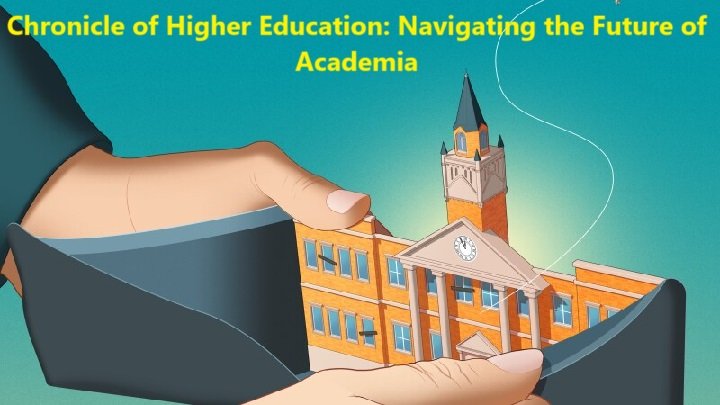
Chronicle of Higher Education
In today’s rapidly evolving world, higher education stands at a crossroads. Institutions, students, and faculty members face new challenges and opportunities that shape the educational landscape. The Chronicle of Higher Education has long been a trusted resource for understanding these dynamics, but as we step into the future, it becomes crucial to examine the issues, trends, and transformations that will define the next era of academia.
The Changing Landscape of Higher Education
Higher education is undergoing a seismic shift driven by technological advancements, globalization, and shifting student demographics. In the past, traditional universities operated in silos, offering static curriculums to local student populations. Today, institutions are more interconnected, and the digital revolution has expanded learning opportunities beyond geographical boundaries.
Online learning platforms have revolutionized the delivery of education, offering flexibility to learners from all walks of life. As a result, many universities are incorporating hybrid models that blend in-person and remote learning. This trend has been accelerated by the COVID-19 pandemic, which forced many institutions to pivot to online instruction. Moving forward, blended learning models will likely become the norm as institutions strive to cater to a more diverse and globalized student body.
At the same time, the rise of micro-credentials and alternative education pathways has challenged the dominance of the traditional four-year degree. Students today are seeking shorter, more focused programs that provide real-world skills and job readiness. This shift is especially apparent in industries like technology, where coding boot camps and certificate programs offer a faster route to employment than traditional degrees.
The Role of Technology in Shaping Higher Education
Technology continues to be a driving force in reshaping the educational landscape. Artificial intelligence (AI), big data, and machine learning are transforming how institutions deliver education, manage administration, and engage with students.
One of the most significant technological trends is the use of AI-powered adaptive learning platforms. These systems analyze student performance and learning habits in real time, offering personalized feedback and resources to improve academic outcomes. This level of customization ensures that students receive targeted support based on their unique strengths and weaknesses.
Moreover, data analytics is revolutionizing higher education by enabling institutions to track student performance and make data-driven decisions. Predictive analytics can identify students at risk of dropping out and allow administrators to intervene early, thus improving retention rates. Similarly, data analysis can help optimize course offerings, ensuring that resources are allocated efficiently and that curricula remain aligned with job market needs.
Furthermore, virtual reality (VR) and augmented reality (AR) are beginning to make their way into classrooms, providing immersive learning experiences. For instance, medical students can now perform virtual surgeries in a risk-free environment, while history students can explore ancient civilizations through VR simulations. These tools enhance engagement and make learning more interactive, offering new possibilities for education.
Globalization and the Internationalization of Higher Education
In today’s globalized world, higher education is no longer confined to national borders. Internationalization has become a key focus for many universities, with institutions striving to attract international students and establish partnerships with universities across the globe. Study abroad programs, cross-border collaborations, and global research initiatives have enriched the academic experience for students and faculty alike.
However, the rise in internationalization also brings challenges. Institutions must navigate issues such as visa policies, cultural differences, and the financial sustainability of attracting international students. In addition, political factors—such as changes in immigration laws or global tensions—can significantly impact student mobility and institutional partnerships.
Despite these challenges, the benefits of internationalization cannot be overstated. A globalized education not only broadens students’ perspectives but also prepares them for the demands of an increasingly interconnected world. Graduates with cross-cultural experiences and global competencies are more likely to succeed in a competitive job market.
The Future of the Workforce and Higher Education
One of the most pressing issues for universities today is how to align education with the future demands of the workforce. As automation and artificial intelligence reshape industries, many of the jobs that exist today may become obsolete. In response, higher education institutions must adapt their curricula to ensure that graduates possess the skills needed in the 21st-century economy.
A greater emphasis on interdisciplinary learning and soft skills—such as critical thinking, collaboration, and communication—will be essential. Universities must also foster lifelong learning mindsets, preparing students for a world where career paths are less linear, and individuals may need to upskill or reskill multiple times throughout their lives.
Additionally, the growing importance of entrepreneurship education cannot be overlooked. As traditional employment models evolve, more graduates are pursuing startups and freelance careers. Universities are increasingly offering entrepreneurship programs, incubators, and mentorship opportunities to nurture the next generation of innovators.
Equity, Access, and Inclusion in Higher Education
As higher education becomes more diverse, issues of equity, access, and inclusion have moved to the forefront of institutional priorities. Ensuring that all students—regardless of their socioeconomic background, race, gender, or disability status—have access to quality education is a critical challenge that universities must address.
This means not only providing financial aid and scholarships but also creating inclusive campus environments where all students feel supported and empowered to succeed. Universities must also address systemic inequalities within their admissions processes, faculty hiring, and curricular design to create truly equitable learning environments.
Moreover, as the student body becomes more diverse, universities must adapt their support services to meet the needs of non-traditional students, such as adult learners, first-generation students, and part-time students. This could include offering more flexible learning options, such as evening classes or remote learning opportunities.
Sustainability and the Role of Universities in Addressing Global Challenges
As the world grapples with issues such as climate change, resource depletion, and socioeconomic inequality, universities have a unique role to play in addressing these global challenges. Many institutions are incorporating sustainability into their curriculums, research initiatives, and campus operations.
Sustainable campuses—which prioritize energy efficiency, waste reduction, and environmentally friendly practices—are becoming more common. Additionally, universities are increasingly offering programs in environmental science, renewable energy, and sustainability management to equip students with the knowledge and skills needed to tackle these pressing issues.
Research universities, in particular, are at the forefront of developing innovative solutions to global problems. By fostering cross-disciplinary research and collaborative projects, universities can drive positive change on a global scale, contributing to a more sustainable and equitable future.
Conclusion: The Path Forward for Higher Education
As we look to the future, it is clear that higher education will continue to evolve in response to technological advancements, workforce demands, and global challenges. Universities must remain agile, innovative, and committed to preparing students for an ever-changing world. By embracing new learning models, fostering global partnerships, and prioritizing equity and sustainability, higher education institutions can thrive in the 21st century.
Read Also: Sex Education Season 4 Cast






